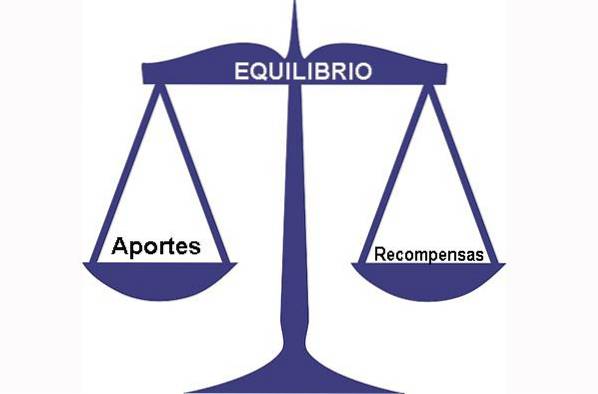
Theory of labor equity model, applications and examples

The labor equity theory focuses on determining whether the distribution of resources is fair for both relational partners at work, the employer and the employee. Equity is measured by comparing the proportion of contributions and rewards for each person.
The core of the theory of labor equity is the principle of balance or equity. According to this theory of motivation, the level of motivation of an individual correlates with his perception of fairness, impartiality and justice practiced by the management of the company. The higher the individual's perception of equity, the higher the level of motivation and vice versa..

The theory of labor fairness requires that a fair balance be struck between an employee's contributions (hard work, skill level, acceptance, enthusiasm, etc.) and the rewards that the employee gets (salary, benefits, intangibles such as recognition, etc.).
According to this theory, finding this fair balance serves to ensure that a strong and productive relationship with the employee is achieved. This will result in happy and motivated employees..
Article index
- 1 Equity assessment
- 2 Model of labor equity theory
- 2.1 -Motivational model
- 2.2 -Balance between contributions and rewards
- 2.3 -Reference groups
- 3 Applications
- 3.1 Business environment
- 3.2 Assumptions applied in business
- 3.3 Implications for managers
- 4 Examples
- 4.1 Other situations
- 4.2 Moderator variables
- 5 References
Equity assessment
When evaluating equity, the employee compares the information of his contribution with his reward, also comparing this same with that of other members of the same level or category. To make such a comparison, the reward / contribution ratio is used.
Equity is perceived when this relationship is the same. If this relationship is unequal, it leads to an "equity strain." This is a state of negative tension that motivates the worker to do something right to alleviate this tension..
The theory of workplace equity was first developed in the 1960s by John Stacey Adams, an occupational and behavioral psychologist.
This psychologist stated that employees seek to maintain equity between the contributions they give to work and the rewards they receive from it, against the contributions and rewards they receive from others.
Labor equity theory model
The theory of labor equity is based on the statement that employees are demotivated, both in relation to their work and with their employer, if they feel that their contributions to the company are greater than the rewards obtained.
Employees can be expected to respond to this in different ways, to the extent that the employee perceives a disparity between their contributions and rewards, such as demotivation, reduced effort, showing discontent, or, in more extreme cases, even being disruptive..
Like other motivation theories, such as Maslow's hierarchy of needs and Herzberg's motivational factors, the theory of job equity recognizes that subtle and variable factors affect each person's evaluation and perception of their relationship with their work and your employer.
-Motivational model
The equity theory model extends beyond the individual self. This model also includes comparison with the situation of other people, forming a comparative vision of equity. This is going to manifest as a sense of what is fair.
This means that equity does not depend only on our reward / contribution relationship, but depends on the comparison between our relationship and the relationship of others..
Therefore, the theory of labor equity is a motivational model much more complex and sophisticated than the mere evaluation of contribution and reward..
This comparative aspect of equity theory provides a much more fluid and dynamic assessment of motivation than that which arises in motivational theories and models based solely on individual circumstances..
Situation assessment
Equity, and therefore the motivational situation to be evaluated using the model, does not depend on the extent to which the person believes that their reward exceeds their contribution.
Rather, the sense of justice that commonly sustains motivation depends on the comparison that a person makes between their reward / contribution relationship with the relationship that other people have in a similar situation..
Therefore, the theory of labor equity helps explain why pay and conditions alone do not determine motivation..
-Balance between contributions and rewards
It is important to take into account the factors of the theory of job fairness that strive to improve job satisfaction and the level of motivation of an employee. Similarly, what can be done to promote higher levels of each.
For this, the balance or imbalance that exists between the contributions and rewards of an employee must be considered.
Contributions
- Effort.
- Loyalty.
- Commitment.
- Skill.
- Ability.
- Adaptability.
- Flexibility.
- Acceptance of others.
- Determination.
- Enthusiasm.
- Support for colleagues.
- Personal sacrifice.
Rewards
- Salaries (salary, monetary and non-monetary benefits).
- Recognition.
- Reputation.
- Responsibility.
- Sense of accomplishment.
- Praise.
- Stimulus.
- Sense of advancement / growth.
- Job security.
Although many of these elements cannot be perfectly quantified and compared, the theory holds that managers must strike a fair balance between the contributions an employee provides and the rewards received..
According to the theory, employees will be happy when they perceive that these factors are in balance.
The idea behind the theory of workplace equity is to strike a healthy balance, with rewards on one side of the scale and contributions on the other. Both must have a weight that looks reasonably the same.
If the balance is too much in favor of the employer, some employees will busy themselves in striking a balance between contributions and rewards, asking for more compensation or recognition. Others will be unmotivated, and others will look for another job.
-Reference groups
A referent group is a selection of people with whom an individual relates, or uses when compared to a larger population. The chosen referent is a significant variable in the theory of labor equity.
If a salesperson is compared with the rest of the sales staff, the reference group is the sales staff.
According to the theory of labor equity, the four basic reference groups that people use are:
Self-in
It's own experience within the current organization ('When I worked for Bob, things were better'). Individuals seek to maximize their rewards.
Self-outside
It is my own experience within another organization ('When I did this same job for XYZ company, they paid me much less').
Groups can maximize collective rewards by developing accepted systems for equitably distributing contributions and rewards among their members..
Others-in
Other people within the current organization ('The management team sits at a conference table all day, and for doing just that they get paid too much').
When individuals find themselves participating in unfair relationships, they become distressed. The more unequal this relationship, the more anguish individuals will feel.
Others-outside
Other people outside the current organization ('Our competitor has some pretty weak benefits').
People who perceive that they are in an unfair relationship try to eliminate their distress by restoring fairness.
Applications
In terms of how theory is applied to work, each person seeks a fair balance between what they bring to work and what they get out of it..
We all arrive at our measure of fairness by comparing our balance of contribution and reward to the balance enjoyed by other people, which we regard as relevant benchmarks or examples..
The theory of equity explains why people can one day be happy and motivated by their situation, and without having changes in their working conditions they can become very unhappy and unmotivated, when they discover that a colleague (or worse, a group) enjoy a better reward-contribution ratio.
It also explains why giving a promotion or raise to one person can have a demotivating effect on others..
It is the subtle variables that play an important role in the sentiment of fairness. Acknowledging job performance or simply thanking the employee will cause a sense of satisfaction. This will make the employee feel valuable and have better results in their work.
Business environment
The theory of job fairness has been widely applied by industrial psychologists in business settings. It serves to describe the relationship between an employee's motivation and their perception of fair or unfair treatment.
In the business environment, the relevant dyadic relationship is that between the employee and the employer. As in a marriage, the theory of labor equity assumes that employees seek to maintain an equitable relationship between the contributions they make to the relationship and the rewards they receive from it..
However, the theory of labor equity introduces the concept of social comparison, according to which employees evaluate their own reward / contribution indicators based on comparing them with the reward / contribution indicators of other employees.
The theory has far-reaching implications for employee motivation, efficiency, productivity, and turnover..
Assumptions applied in business
The three main assumptions of equity theory applied in most businesses can be summarized as follows:
- Employees expect a fair and equitable reward for what they contribute to their jobs. Therefore, this is a concept called "equity rule".
- Employees determine what their equitable reward should be after comparing their contributions and rewards with those of their co-workers. This concept is known as "social comparison".
- Employees who perceive themselves to be unfair will attempt to reduce inequity by distorting contributions and / or rewards in their minds ("cognitive distortion"), directly altering their contributions and / or rewards, or by leaving the organization..
Implications for managers
- People measure their total contributions and rewards. This means that a working mother can accept lower monetary compensation in exchange for more flexible working hours..
- Each employee attributes their own personal values to contributions and rewards. Therefore, two employees of the same experience and qualification, doing the same work for the same salary, may have quite different perceptions of the fairness of treatment..
- Employees can adjust to purchasing power and local market conditions.
- Although it can be accepted that higher-ranking personnel receive a higher remuneration, there are limits on the amount of the balance of equity. Employees May Find Overpaying Executives Demotivating.
- Staff perceptions of your contributions and rewards, and those of others, may be wrong. These perceptions must be managed effectively.
Examples
You can identify the theory of equity in the workplace by listening to the phrases people use in conversation.
Commonly, individuals compare their role to that of someone who is paid more than they are. The theory of job fairness comes into play when people say something like:
- "Andy makes more than I do, but he doesn't do as much work!".
- "They pay me a lot less than Andy, but this place would fall apart without me!".
- “You heard that the new guy makes $ 500 more and works fewer hours. Is that fair? "
In each of these examples, someone compares their own reward and contribution to someone else's. Although comparing reward is the most common, other typical forms of comparison include comparing learning opportunities or comparing opportunities to work from home.
Other situations
The theory of job fairness comes into play whenever employees say things like, “They pay Juan a lot more than me, but they don't give him as much work,” or “They pay me a lot less than Janeth, but this place it couldn't work without me ".
In each of these situations, someone is comparing their own reward-contribution relationship with someone else's, losing motivation in the process..
The goal of this theory is to explain why people may be happy one day, and suddenly lower their level of motivation after discovering that others enjoy better rewards for their contributions..
Dissatisfaction often leaves the employee demotivated. This results in lower productivity and, in some cases, wear.
Moderator variables
Gender, salary, education, and level of experience are moderating variables. More educated individuals are more informed. Therefore, they are likely to be compared to outside jobs or people.
Men and women prefer to compare themselves to the same sex. It has been observed that women are typically paid less than men in comparable jobs. They also have lower salary expectations than men for the same job.
Therefore, an employee who uses another employee as a reference tends to have a lower comparative standard.
Older employees know their organization very well and compare themselves to their own peers. On the other hand, less experienced employees rely on their personal knowledge to make comparisons.
References
- Wikipedia, the free encyclopedia (2018). Equity theory. Taken from: en.wikipedia.org.
- Mindtools (2018). Adams' Equity Theory. Taken from: mindtools.com.
- The Economic Times (2018). Definition of 'Equity Theory'. Taken from: economictimes.indiatimes.com.
- Study (2018). Equity Theory of Motivation in Management: Definition & Examples. Taken from: study.com.
- Prachi Juneja (2018). Equity Theory of Motivation. MSG. Taken from: managementstudyguide.com.
- Businessballs (2018). Adams' Equity Theory on Job Motivation. Taken from: businessballs.com.
- Expert Program Management (2018). Equity Theory - Keeping Employees Motivated. Taken from: expertprogrammanagement.com.



Yet No Comments